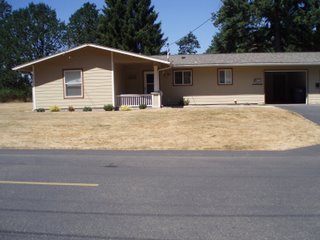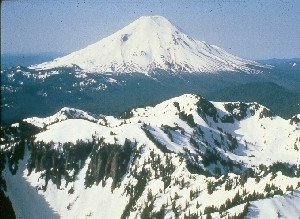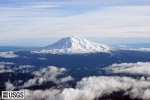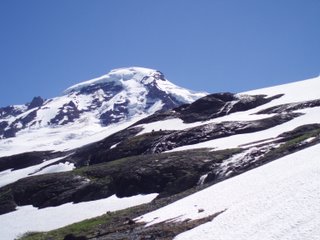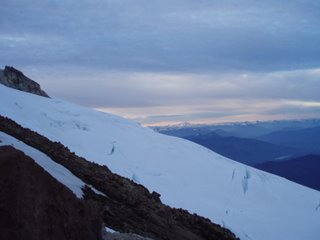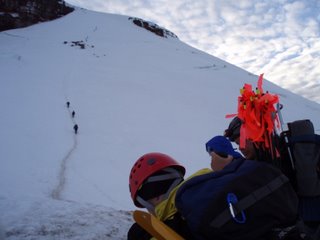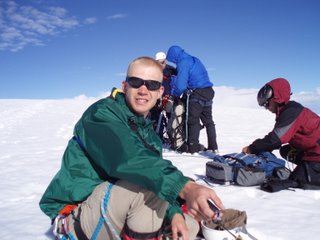
I was originally scheduled on in the class to climb Mt. Adams on July 22-23, two weeks after Mt. Baker. Because Ariele and I are moving into a new home that weekend, I was able to coordinate with the instructor to go with a different group and move it up a week. I wasn’t sure that I would be able to do this until 2 days before the climb, and I had a only 5 days to recover from the climb up Mt. Baker before climbing Adams. I thought that Mt Adams would be similar to in difficulty, but I was wrong. It turned out to be a much more difficult and challenging climb.
The weekend started Friday afternoon when Ken, Chris, Dan and Melissa picked me up at home we started the long drive down to Trout lake. The drive was a lot of fun, and I enjoyed the company. We stopped several times, including and stop for dinner in Cougar, WA. At the Washington-Oregon border, we turned east towards Mt. Adams. I had never been down that road before and it was a very scenic drive. We spent the night at a county park in Trout lake, WA and got to the trailhead at Bird Creek Meadows in the Yakima Indian Reservation first thing on Saturday morning.
The first thing I noticed when I got to the trail head was the mosquitoes. They were so hungry they even bit through my shirt and ignored the bug repellent I put on. In fact the only thing the bug repellent did was mix with the sunscreen to create a sticky mess on my skin. After half an hour of prepping gear and ineffectually swatting mosquitoes our group of 10 climbers left the trailhead for Sunrise camp, at 8340’ on the southeast slope of Mt. Adams.
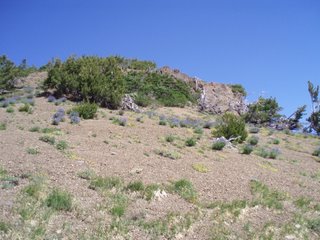 The hike in to high camp was only 3 miles, but it took jus five hours to get there. The trail was hard to follow, and there were several places where the trail disappeared in a maze of volcanic rocks. It was fascinating to do hike on the opposite end (NW vs. SE) on the WA cascades from Mt. Baker, and only a week later. There was very stark difference in the vegetation on the two mountains. Mt. Baker was very lush and green and covered in plants, while Mt. Adams seemed semi-arid and in many ways similar to mountains in CA. Both mountains were beautiful and I enjoyed every minute that I spent on them.
The hike in to high camp was only 3 miles, but it took jus five hours to get there. The trail was hard to follow, and there were several places where the trail disappeared in a maze of volcanic rocks. It was fascinating to do hike on the opposite end (NW vs. SE) on the WA cascades from Mt. Baker, and only a week later. There was very stark difference in the vegetation on the two mountains. Mt. Baker was very lush and green and covered in plants, while Mt. Adams seemed semi-arid and in many ways similar to mountains in CA. Both mountains were beautiful and I enjoyed every minute that I spent on them.
About an hour after leaving the tree line, our instructors lead us to a wonderful place to take a break for lunch. Inside a depression in the volcanic rocks was a small lake that had been frozen during the winter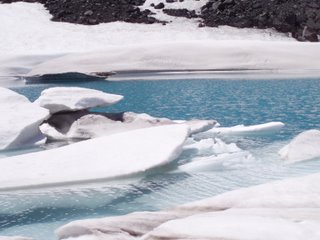 and even in July was still only partly thawed. It was as if we had walked into the artic in summer time. Several people went out onto the iceberg on the lake and got a better look at it, and then we moved on to high camp.
and even in July was still only partly thawed. It was as if we had walked into the artic in summer time. Several people went out onto the iceberg on the lake and got a better look at it, and then we moved on to high camp.
Saturday was a perfect day to spend at high camp. It was sunny, but not too hot, breezy, but not windy and high camp was open and snow free. After all the tents were set up, I went with three other people to sit in the shade and eat dinner. As we ate, we spotted a family of mountain goats nearby and watched them wander around the outskirts of our camp. When we returned we found that the rest of the group had put together a wildly entertaining game of Bocce rock. When the game was finished, we had a final briefing and everyone went back to their tents and went to sleep at around 7pm. I was alone in my tent because there was an odd number of people, and because of the breeze, I couldn’t sleep without earplugs.
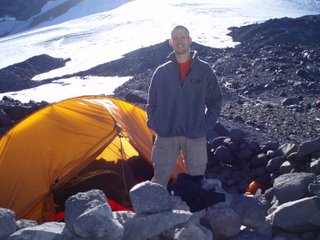
At 2am, Dan tried several times before waking me up, because of the earplugs I was wearing, and I scrambled to get ready to go before the 0230 deadline. It was surprisingly warm out for the mountain and time, so I was equally surprised to find that the snow had turned to ice and we needed to wear crampons. Putting on the crampons delayed our start until about 0300.
The glacier got right down to business and started steep and then got worse. I think the majority of our day’s climb was on slopes around 45 degrees. It took some time for me to get used to the exposure, and I was very scared of the height and the steepness for the first hour or more of the climb. I felt better I prayed about it and Ken reminded me that I wasn’t going anywhere. If I fell, the other two members of my rope team would keep me from falling far. Soon we started to see the light of the sunrise over the horizon. It was stunningly beautiful, and the many colors reminded me of my wife and her closet. I saw all the colors of the rainbow on the horizon, with red at the bottom, and blue and purple in the sky that was still mostly dark.
After 3 or 4 hours of climbing, we reached a small flat spot on the glacier and turned west to leave the glacier and cross over onto the south climb route. From there it was just a log snow slog up 2000’ to the summit of Mt. Adams. It was slow going, as we had been moving for 6 hours already, and the air is much thinner at 10,000’ and we had to breathe slowly and deeply to give our bodies enough air to not get sick.
At 0930, after over 7 hours of climbing steep slopes, we reached the summit of Mt. Adams. The view was 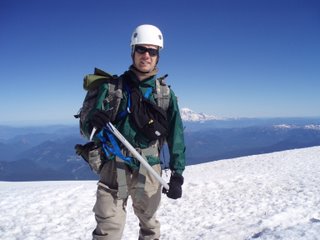 breathtaking. To the south were Mt. Hood, Mt. Jefferson, the Three Sisters, and then and fourth mountain range we could not identify. To the north were Mt. St. Helens, Mt. Rainier, and in the distance over 250 miles away, was Mt. Baker. It was cold, windy and high at the summit, so we stayed only long enough to take some pictures, have a snack and then head down.
breathtaking. To the south were Mt. Hood, Mt. Jefferson, the Three Sisters, and then and fourth mountain range we could not identify. To the north were Mt. St. Helens, Mt. Rainier, and in the distance over 250 miles away, was Mt. Baker. It was cold, windy and high at the summit, so we stayed only long enough to take some pictures, have a snack and then head down.
It took us 4 hours to get back to high camp, and then another 4 hours to pack up and get back to the trail head. In all, on Sunday we spent 13 of 14 hours on our feet with packs on ours backs, climbed 4,000’ and then descended 7,000. It was a long day. Despite being much more challenging, I felt much better after Adams than after Baker, and I was sore only 2 days instead of 4. It was an awesome climb, but I don’t think it is one that I will repeat again soon. With this climb, my class is now over, except for the picture party next month. I will miss it very much, and hope that it is not too long before I can find someone to climb with again.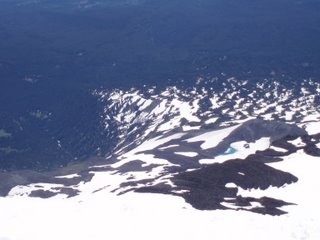
I would like to thank God for not letting me die, and helping me get deal with my fear of heights. Also to my wife for supporting me taking this class and climb, and letting me use her equipment that helped me a lot on Mt. Adams.
